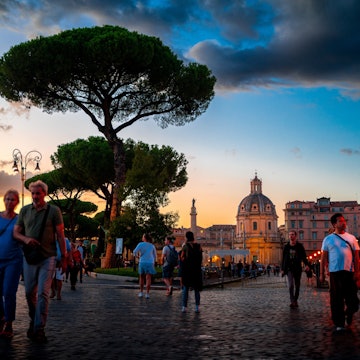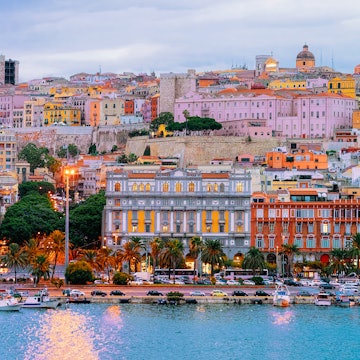

A visit to the opulent Vatican Museums can be overwhelming – and thrilling, unforgettable and must-do for anyone who comes to Rome. red-feniks/Shutterstock
With 28 centuries under its belt, Rome has so much history and art to showcase. About 250 museums exist in the Eternal City; some of them are within Renaissance palaces, while others are open-air attractions or archaeological parks like the Colosseum, Terme di Caracalla (Baths of Caracalla) and Circo Massimo.
The vast majority of attractions are a testament to the glory of Ancient Rome. Still, many museums also display more recent history, from the Middle Ages to the Renaissance to the Baroque, and others focus specifically on modern and contemporary art.
It’s worth mentioning that, while not technically museums, Rome has more than 900 churches, many of which house hundreds of world-famous masterpieces. Seek them out and enjoy a combination of art, architecture and history.
No matter what you appreciate the most, Rome has something for everyone. Here are 8 of the best museums in Rome to start your journey.

1. Capitoline Museums
The oldest public museum in the world
If you only have time for one museum during your stay in Rome, let it be the Musei Capitolini. Considered the first public museum in the world, it dates back to 1471, when Pope Sixtus IV gifted a collection of Ancient Roman statues to the people of Rome. In the intervening centuries, the museum has acquired many more items. Today, the Capitoline Museums house 70,000 works of art (although not all are on display simultaneously), including archaeological finds, sculptures and paintings, from antiquity and the Middle Ages to the Renaissance and Baroque eras. Don’t miss the Venus Capitolina, the Hall of Curiatii and Horatii, and the colossal head of Constantine.
Planning tip: Set aside at least a couple of hours for your visit - you won’t want to rush this.

2. Villa Giulia
Best for Etruscan art
Before Rome became, well, Rome, much of central Italy was inhabited and controlled by the Etruscans, a people of extraordinary engineering talent. ETRU, the National Etruscan Museum of Villa Giulia, is the top institution on Etruscan culture. It proudly showcases more than 6,000 works of Etruscan art in the walls and grounds of a Renaissance palace built for Pope Julius II, then restructured in the 1700s in a manierist style. The building alone, with its courtyards and nymphaeum, is worth a trip.
The Etruscan collection includes must-see works like the Sarcophagus of the Spouses, the statue of Apollo found at Veio, and parts of Etruscan temples and buildings, masterpieces of Etruscan engineering to remind you where the Ancient Romans learned the art from.

3. Ostia Antica
Best for a break from the city
Take a break from the city and head to an open-air museum. The Archaeological Park of Ostia Antica will show you an almost perfectly preserved ancient Roman city. Ostia Antica was once a far-off town serving as Rome’s seaport, but urbanization has made modern Ostia one of Rome’s districts. Today, you can walk across the main streets of Ostia Antica (easily reachable with public transportation from the city center) to understand what the layout of an ancient Roman city looked like, with ruins of its buildings, temples and theaters. Even some statues and mosaics have endured to this day.
Detour: For a similar experience elsewhere in Rome, you can visit the Via Appia Antica, the world’s oldest highway.

4. Villa Torlonia
Best for eclectic style
An underdog in a sea of much more famous museums and located in the youngest of Rome’s princely villas, the museums of Villa Torlonia are spread over multiple buildings in the eponymous park.
Obelisks and columns greet visitors before entering the main building, Casino Nobile, inside of which each room is a treasure, with frescoed walls, mosaics and statues, and all decorated with a mix of styles, from Egyptian to Roman to Gothic to Neoclassic. The next building, Casino dei Principi, hosts temporary art exhibits and the Archives of the Roman school. Lastly, Casina delle Civette is built in the style of a countryside cottage out of a fairytale and predominantly depicts animals and nature.

5. Centrale Montemartini
Best for Roman sculptures
The once-industrial Ostiense district hosts Rome’s largest museum for Roman sculptures inside a former power plant left intact, Centrale Montemartini. Other museums display plenty of classical sculptures in Rome (Museo Giovanni Barraco, Palazzo Braschi, Palazzo Altemps, Palazzo Massimo, among others), but the stark contrast between the industrial setting of Centrale Montemartini and the ancient marble statues makes this place unique. At the end of a journey through time, the last room of the museum houses three cars of the train owned by Pope Pius IX in 1858.

6. MAXXI
Best for contemporary art
Fast forward to our time and visit the unconventional MAXXI, which stands for Museo delle Arti del XXI Secolo (“Museum of the Arts of the 21st Century”) in the Flaminio district. Italy’s very first museum dedicated to contemporary art, MAXXI hosts and produces thought-provoking exhibitions of art, architecture, design and photography exhibits, plus events on cinema, dance, fashion, music and theatre. More than a mere museum, MAXXI is an inclusive platform celebrating creativity and dialogue, often spotlighting works of young artists. The museum also organizes workshops for people of all ages.

7. Museo e Galleria Borghese
Best for an extraordinary collection
Within the massive park of Villa Borghese, Galleria Borghese reigns supreme. This residence of the princely Borghese family was built in the 1600s and refurbished in Neoclassical style in the 1770s. The museum’s vast collection is made up of ancient sculptures and paintings ranging from the 15th to 19th centuries, including works by Raphael, Titian, Caravaggio and statues by Canova. The palace, with its frescoed ceilings, is a work of art in itself.
Planning tip: Book your visit to the museum ahead of time. Villa Borghese has various entrances; the one closest to the Galleria is on Via Pinciana.

8. Vatican Museums
The longest museum itinerary in Europe
The Vatican Museums, though technically located in Vatican City, are the largest in Rome. The popes commissioned and acquired about 70,000 works of art housed in the Vatican Museums, of which only 20,000 are on display. Michelangelo’s Sistine Chapel is possibly the most famous part of the museum; this is where cardinals lock themselves in to elect a new pope. The Vatican Museums are also home of ancient Egyptian, Greek, Etruscan and Roman artifacts and statues, and Medieval, Renaissance and Baroque art (including works by Giotto, Leonardo, Rafael, Titian, Michelangelo, Caravaggio). Other must-see areas include the Gallery of Maps and the Rafael rooms; the gardens, too, deserve a visit.
Planning tip: This is one of the city’s busiest tourist attractions. It’s best to book tickets online months in advance, although you can also wait in line.
Tickets to museums in Rome
Most archaeological sites and major museums are public. Some of them are always free, and some are free the first Sunday of the month. Usually, public museums don’t charge children and EU citizens under 18, while EU students under 26 and over 60 can get discounted fees. However, this may vary and usually does not apply to privately owned museums. Check every museum’s website to understand whether you or someone you are traveling with is eligible for a gratuity or discount.
















